Martian rock crushed by Curiosity hides a surprise!
NASA first published this original article on July 18, 2024. Edits by EarthSky.
Researchers shocked by hidden contents of Martian rock
Scientists were stunned on May 30, 2024, when a Martian rock that NASA’s Curiosity Mars rover drove over cracked open to reveal something never seen before on the red planet: yellow sulfur crystals.
Since October 2023, the rover has been exploring a region of Mars rich with sulfates, a kind of salt that contains sulfur and forms as water evaporates. But where past detections have been of sulfur-based minerals – in other words, a mix of sulfur and other materials – the rock Curiosity recently cracked open is made of elemental, or pure, sulfur. It isn’t clear what relationship, if any, the elemental sulfur has to other sulfur-based minerals in the area.
While people associate sulfur with the odor from rotten eggs (the result of hydrogen sulfide gas), elemental sulfur is odorless. It forms in only a narrow range of conditions that scientists haven’t associated with the history of this location. And Curiosity found a lot of it – an entire field of bright rocks that look similar to the one the rover crushed.
Curiosity’s project scientist Ashwin Vasavada of NASA’s Jet Propulsion Laboratory explained why researchers were so surprised:
Finding a field of stones made of pure sulfur is like finding an oasis in the desert. It shouldn’t be there, so now we have to explain it. Discovering strange and unexpected things is what makes planetary exploration so exciting.
A ‘curious’ discovery
It’s one of several discoveries Curiosity has made within Gediz Vallis channel, a groove that winds down part of the 3-mile-tall (5-kilometer-tall) Mount Sharp, the base of which the rover has been ascending since 2014. Each layer of the mountain represents a different period of Martian history. Curiosity’s mission is to study where and when the planet’s ancient terrain could have provided the nutrients needed for microbial life, if any ever formed on Mars.

Image via NASA/JPL-Caltech/MSSS
Evidence hints violent ancient floods and avalanches shaped Mars
Gediz Vallis channel is one of the primary reasons the science team wanted to visit this part of Mars. Scientists think that the channel was carved by flows of liquid water and debris that left a ridge of boulders and sediment extending 2 miles (3.2 km) down the mountainside below the channel. The goal has been to develop a better understanding of how this landscape changed billions of years ago, and while recent clues have helped, there’s still much to learn from the dramatic landscape.
Since Curiosity’s arrival at the channel earlier this year, scientists have studied whether ancient floodwaters or landslides built up the large mounds of debris that rise up from the channel’s floor here. The latest clues from Curiosity suggest both played a role: some piles were likely left by violent flows of water and debris, while others appear to be the result of more local landslides.
Those conclusions are based on rocks found in the debris mounds: Whereas stones carried by water flows become rounded like river rocks, some of the debris mounds are riddled with more angular rocks that may have been deposited by dry avalanches.
Finally, water soaked into all the material that settled here. Chemical reactions caused by the water bleached white “halo” shapes into some of the rocks. Erosion from wind and sand has revealed these halo shapes over time.
Becky Williams, a scientist with the Planetary Science Institute in Tucson, Arizona, and the deputy principal investigator of Curiosity’s Mast Camera, or Mastcam, described the early mayhem on the red planet:
This was not a quiet period on Mars. There was an exciting amount of activity here. We’re looking at multiple flows down the channel, including energetic floods and boulder-rich flows.
Martian rock discovery: A hole in 41
All this evidence of water continues to tell a more complex story than the team’s early expectations, and they’ve been eager to take a Martian rock sample from the channel in order to learn more. On June 18, 2024, they got their chance.
While the sulfur rocks were too small and brittle to be sampled with the drill, a large Martian rock nicknamed “Mammoth Lakes” was spotted nearby. Rover engineers had to search for a part of the rock that would allow safe drilling and find a parking spot on the loose, sloping surface.
After Curiosity bored its 41st hole using the powerful drill at the end of the rover’s 7-foot (2-meter) robotic arm, the six-wheeled scientist trickled the powdered rock into instruments inside its belly for further analysis so that scientists can determine what materials the rock is made of.
Curiosity has since driven away from Mammoth Lakes and is now off to see what other surprises are waiting to be discovered within the channel.
Bottom line: The rover Curiosity found sulfur crystals in a Martian rock for the first time. Researchers say they shouldn’t be there and are seeking an explanation.
Weird Rock on Mars May Actually Show Signs of Ancient Life
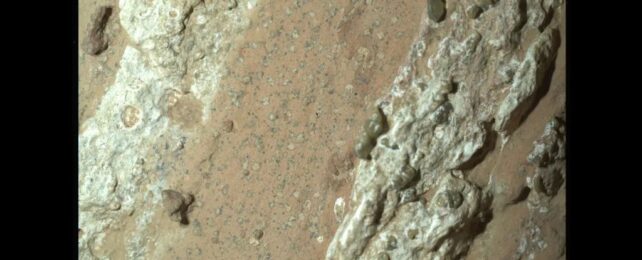 This unassuming rock could be harboring signs of life. (NASA/JPL-Caltech/MSSS)
This unassuming rock could be harboring signs of life. (NASA/JPL-Caltech/MSSS)A rock on Mars is speckled with signs that it may have hosted life-supporting chemistry billions of years ago.
Found on the edge of an ancient river valley by the Perseverance rover and named Chevaya Falls, the veiny sedimentary material contains organic compounds and leopard-like spots that indicate chemical reactions chemosynthetic microbes could have once used for energy.
"These spots are a big surprise," says astrobiologist David Flannery of the Queensland University of Technology in Australia. "On Earth, these types of features in rocks are often associated with the fossilized record of microbes living in the subsurface."
A growing pile of evidence increasingly indicates conditions on Mars would have been hospitable to life as we know it, once upon a time. There was water; there was chemistry; the conditions for the formation of the building blocks of life were possible.
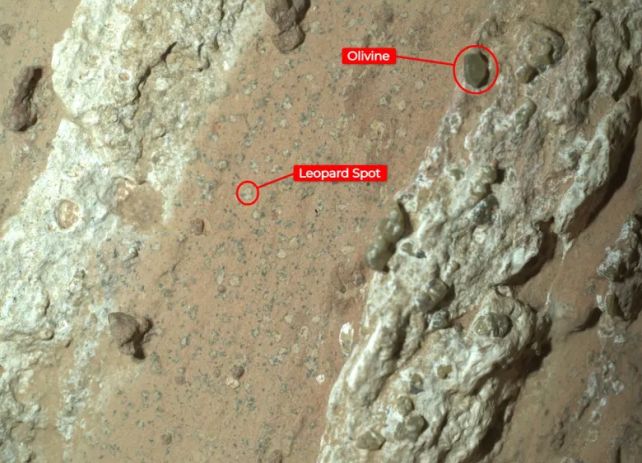
Scientists think that if we do find signs of life, it would be similar to the first life on Earth; microbial, and optimized for low- to no-oxygen conditions.
What remains of this life on Earth can be difficult to parse, consisting of layers of fossilized microbial mats sandwiched between layers of sedimentary rock. Part of Perseverance's remit – a large part, actually – is to look for similar signs on Mars.
So it's patrolling a region on the red planet that was once a wetland, studying sedimentary rocks in earch of signatures that we would recognize as biological here on Earth.
When Perseverance found and then drilled Chevaya Falls, it found the strongest such signs we've seen on Mars to date.
The sample analyzed by the rover revealed organic, carbon-rich material. There is a lot of organic material on Mars, but there are also a lot of non-biological processes that can produce organic material, meaning the presence of such is not diagnostic in and of itself.
In the presence of other possibly biological signs, however, the presence of organic material becomes more significant.
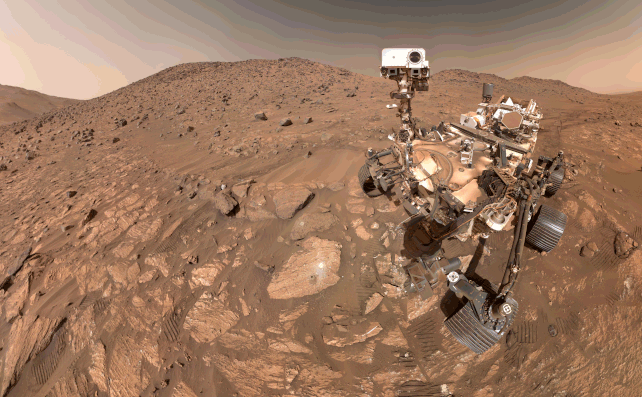
We know that Chevaya Falls was once exposed to water. That's step one. The rock is banded by layers of calcium sulfate separated by seams of hematite – the very same mineral that makes Mars so ruddy.
And in those seams are small white spots, bordered in black, like the spots of a leopard. These black borders around the spots contain iron and phosphate.
Spots like this form when a chemical reaction involving the hematite in the rock turns a patch from red to white, releasing iron and phosphate, and causing black rings to form. These reactions can produce chemistry that microbes can use as an energy source.
In addition, Chevaya Falls contains olivine, a mineral that forms in volcanic rock. This means that there are other formation mechanisms that don't invoke the presence of microbes that can explain the observed features.
Repeated exposure to water and superheating in volcanic conditions may also have produced the veins, spots, and olivine inclusions in Chevaya Falls.
For now, there's nothing more we can learn about the rock. Perseverance has exhausted its repertoire of instruments. But it also took a sample that is now waiting in a tube for a spacecraft to one day come and collect it and bring it back to Earth – hopefully.
It may, however, represent the strongest incentive yet for finally getting our human butts to Mars and taking a look for ourselves.
"Cheyava Falls is the most puzzling, complex, and potentially important rock yet investigated by Perseverance," says geochemist Ken Farley of Caltech.
"On the one hand, we have our first compelling detection of organic material, distinctive colorful spots indicative of chemical reactions that microbial life could use as an energy source, and clear evidence that water – necessary for life – once passed through the rock.
"On the other hand, we have been unable to determine exactly how the rock formed and to what extent nearby rocks may have heated Cheyava Falls and contributed to these features."
NASA's Perseverance Mars rover finds possible signs of ancient Red Planet life
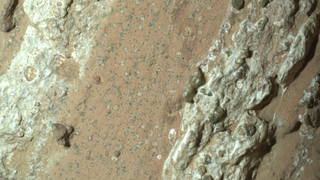
NASA's Perseverance rover may have found signs of ancient life in a rock on Mars; the mission team's scientists are ecstatic, but remain cautious as further analysis is needed to confirm the discovery.
The rover has come across an intriguing, arrowhead-shaped rock that hosts chemical signatures and structures that could have been formed by microbial life billions of years ago, when Mars was significantly wetter than it is today. Inside the rock, which scientists have nicknamed "Cheyava Falls," Perseverance's instruments detected organic compounds, which are precursors to the chemistry of life as we know it. Wisping through the length of the rock are veins of calcium sulfate, which are mineral deposits that suggest water — also essential for life — once ran through the rock.
The rover also found dozens of millimeter-sized splotches, each surrounded by a black ring and mimicking the appearance of leopard spots. These rings contain iron and phosphate, which are also seen on Earth as a result of microbe-led chemical reactions.
"These spots are a big surprise," David Flannery, an astrobiologist and member of the Perseverance science team from the Queensland University of Technology in Australia, said in a statement. "On Earth, these types of features in rocks are often associated with the fossilized record of microbes living in the subsurface."
Related: 'An oasis in the desert': NASA's Curiosity rover finds pure sulfur in Martian rocks
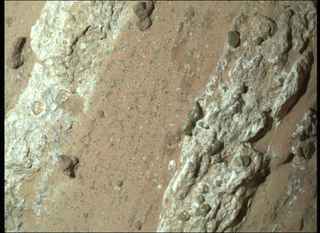
A better look at the exciting rock detected by Perseverance.
"We've never seen these three things together on Mars before," Morgan Cable, a scientist on the Perseverance team, said in a video NASA posted to YouTube today (July 25).
Cheyava Falls sits at the edge of an ancient, 400-meter-wide (437-yard-wide) river valley named Neretva Vallis. Scientists suspect this ancient channel was carved out long ago due to water gushing into Jezero Crater; Neretva Vallis runs along the inner wall of this region. In one possible scenario, mud that already possessed organic compounds got dumped into the valley and later cemented into the Cheyava Falls rock, which Perseverance sampled on July 21. A second episode of water oozing into the formed rock would have created the object's calcium sulfate veins and black-ringed spots the team sees today.
Get the Space.com Newsletter
Breaking space news, the latest updates on rocket launches, skywatching events and more!Contact me with news and offers from other Future brandsReceive email from us on behalf of our trusted partners or sponsorsBy submitting your information you agree to the Terms & Conditions and Privacy Policy and are aged 16 or over.
To be clear, the rock's visible features aren’t irrefutable evidence of ancient microbial life on Mars — not yet, at least. It is possible, for instance, that the observed calcium sulfate entered the rock at uninhabitably high temperatures, perhaps during a nearby volcanic event. However, whether such non-biological chemical reactions could have resulted in the observed black-ringed spots is an open question, the scientists say.
"This trip through the Neretva Vallis riverbed paid off as we found something we've never seen before, which will give our scientists so much to study," Nicola Fox, the associate administrator of NASA's Science Mission Directorate, said in the statement.
"We have zapped that rock with lasers and X-rays and imaged it literally day and night from just about every angle imaginable," Ken Farley, Perseverance project scientist of Caltech in California, said in the statement. "Scientifically, Perseverance has nothing more to give."
— Little Mars 'snowman' spotted by NASA's Perseverance rover (photo)
— Perseverance rover's Mars rock sample may contain best evidence of possible ancient life
— Perseverance Mars rover digs into intriguing 'Bright Angel' rock formation (photo)
To fully grasp what really unfolded in the ancient river valley billions of years ago, scientists are keen to get the Cheyava Falls sample to Earth, where it can be scrutinized with powerful instruments that Perseverance’s limited suite doesn't have.
The complex Mars Sample Return effort, however, has run into many snags in recent months after its costs spiked to $11 billion. In its current form, the program requires multiple launches to Mars to place a vehicle on the Red Planet, after which either Perseverance will travel to the vehicle and drop off its collected samples, or pop those samples over to a retrieval helicopter that can complete the handoff. Then, an ascender would launch the samples into orbit, where a spacecraft would collect them and return them to Earth.
NASA assessed various simpler alternatives from industry and academic groups and awarded $1.5 million contracts to seven companies looking into the endeavor; three of the agency's own research centers are carrying out studies as well.
Surprise Discovery Hints a Hidden Ocean Is Lurking in The Solar System
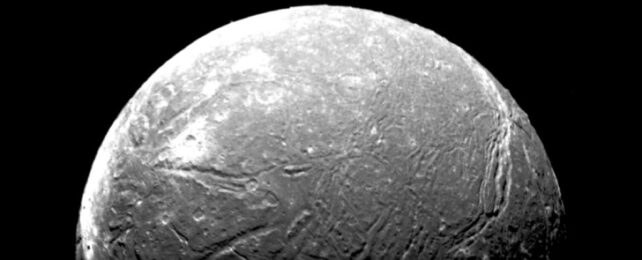 An image mosaic of Uranus’ moon Ariel, taken by the narrow-angle camera on Voyager 2 on Jan. 24, 1986. (NASA/Jet Propulsion Laboratory)
An image mosaic of Uranus’ moon Ariel, taken by the narrow-angle camera on Voyager 2 on Jan. 24, 1986. (NASA/Jet Propulsion Laboratory)Venus is known for being really quite inhospitable with high surface temperatures, and Mars is known for its rusty red horizons. Even the moons of some of the outer planets have fascinating environments with Europa and Enceladus boasting underground oceans.
Recent observations from the James Webb Space Telescope show that Ariel, a moon of Uranus, is also a strong candidate for a sub surface ocean.
How has this conclusion been reached? Well JWST has detected carbon dioxide ice on the surface on the trailing edge of features trailing away from the orbital direction. The possible cause, an underground ocean!
Uranus is the seventh planet in the Solar System and has five moons. Ariel is one of them and is notable for its icy surface and fascinatingly diverse geological features. It was discovered back in 1851 by William Lassell who funded his love of astronomy from his brewing business!
The surface of Ariel is a real mix of canyons, ridges, faults and valleys mostly driven by tectonic activity. Cryovolcanism is a prominent process on the surface, which drives constant resurfacing and has led to Ariel having the brightest surface of all Uranus' moons.
Studying Ariel closeup reveals that the surface is coated with significant amounts of carbon dioxide ice. The trailing hemisphere of Ariel seems to be particularly coated in the ice which has surprised the community.
At the distance of the Uranian system from the Sun, an average of 2.9 billion kilometres, carbon dioxide will usually turn straight into a gas and be lost to space, it's not expected to freeze!
Until recently, the most popular theory that supplies the carbon dioxide to Ariel's surface is interactions between its surface and charged particles in the magnetosphere of Uranus. The process known as radiolysis breaks down molecules through ionisation.
A new study just published in the Astrophysical Journal Letters suggests an intriguing alternative, the carbon dioxide molecules are expelled from Ariel, possibly from a subsurface liquid ocean!
A team of astronomers using JWST have undertaken a spectral analysis of Ariel and compared the results with lab based findings. The results revealed that Ariel has some of the most carbon dioxide rich deposits in the solar system.
The deposits are not just wisps and trace amounts instead adding up to about 10 millimetres across the trailing hemisphere. Furthermore, the results also showed signals from carbon monoxide too, which should not be there given the average temperatures.
It is still possible that radiolysis is responsible for at least some of the deposits but the replenishment from the subsurface ocean is thought to be the main contributor. This hypothesis has been supported by the discovery of signals from carbonate minerals, salts that can only be present due to the interaction between rock and water.
The only way to be absolutely sure is for a future space mission to Uranus. Such a mission will undoubtedly explore the moons of Uranus.
Ariel is covered in canyons, fissures and grooves and it is suspected these are openings to its interior. A robotic explorer in the Uranian system will be able to uncover the origin of the carbon oxides on Ariel.
Without such a mission we are still somewhat in the dark given that Voyager 2 only imaged around 35% of the moon's surface.
Geoscientists narrow timing of enormous 'magmatic event' on the moon more precisely
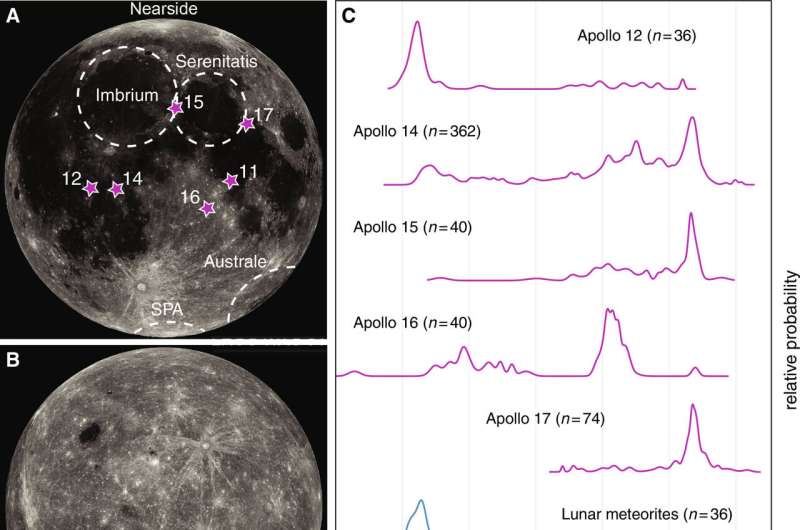
A team of geoscientists affiliated with several institutions in the U.S. and Switzerland has more precisely dated an enormous "magmatic event" that occurred on the moon several billion years ago.
In their study, published in the journal Science Advances, the group dissolved and analyzed zircon samples found in rocks brought back to Earth by astronauts during the Apollo space program and what they learned by doing so.
Prior research has shown that a large and dramatic magmatic event occurred on the moon more than 4 billion years ago. It is not known what caused the event, but many in the field have speculated that it was likely due to a very large impact, possibly the one that resulted in the creation of the South Pole-Aitken basin.
Prior efforts to date the magmatic event have led to an estimation of 4.33 billion years ago. In this new study, the research team made an even more precise estimate.
Minerals have been used by scientists for geochronological dating for many years because they are impacted by magmatic events and retain the changes for long periods of time. For dating events on the moon, scientists have looked to zircon, a mineral found in many of the rocks on the moon's surface. Several such rocks were returned to Earth by astronauts who collected them from the moon's surface in the late 1960s and early 1970s. Analysis of such rocks is typically done using mass spectrometry.
For this new study, the research team took a new look at some of the returned lunar rocks with an approach that had not been used before because it is destructive—they dissolved some of the zircon in several samples, allowing testing of the degree of magmatism in their interiors and surfaces.
They were able to more precisely date the magmatic event to 4.334 to 4.338 billion years ago. They also found that the event was singular, showing that it was not due to a cascade of small objects striking the moon.
The findings by the team add credence to the theory that the magmatic event was caused by a large body colliding with the moon, most likely the one that created the South-Pole-Aitken basin.
More information: Mélanie Barboni et al, High-precision U-Pb zircon dating identifies a major magmatic event on the Moon at 4.338 Ga, Science Advances (2024). DOI: 10.1126/sciadv.adn9871
Journal information: Science Advances
© 2024 Science X NetworkGallium in lunar samples explains loss of moon's easily vaporized elements
A Fortune of Hidden Diamonds Could Be Concealed Inside Mercury
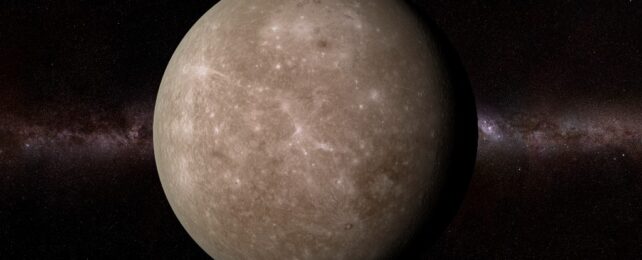
Simulations of Mercury's childhood suggest the runt of the Solar System may have inherited a fortune in the form of a 15-kilometer (9-mile) thick layer of solid diamond.
Sandwiched between the core and the mantle hundreds of miles beneath the surface of a world that orbits within a whisker of our blazing hot Sun, the hypothetical bonanza is decidedly safe from any future spacefaring heists.
But the findings could have implications for the development of rocky planets like Mercury, and possibly explain a thing or two about the tiny planet's mysteriously persistent magnetic field.
A team of scientists from research institutes in China and Belgium were inspired by recent reassessments of Mercury's gravity field models to go back to the drawing board on the potential structuring of its internal environment.
Should the boundary between the core and the mantle turn out to be deeper than previously thought, the conditions for baking various materials out of its molten mineral soup would also need to be reconsidered.
Data from the recent MESSENGER missions has given astronomers the impression that the dark patches on Mercury's surface are mostly made up of carbon in the form of graphite, most likely coughed up from deep below rather than dusted from passing comets.
Running the numbers, sufficient quantities of carbon could have crystallized out of its magma at the boundary between the core and the mantle and floated up, contributing to the planet's crust as graphite.
Having so much graphite on the surface would imply Mercury was saturated with carbon, especially given how easily the element ought to be lost early in the planet's formation in the form of carbon dioxide and methane gasses.
Diamond is also a solid molecule made from carbon, of course, but has previously been ruled out as a possible product given insufficient pressures close to Mercury's core. Now, researchers think Mercury was possibly capable of giving its core a big ol' squeeze after all.
Using thermodynamic modeling to arrive at a deeper core-mantle boundary featuring greater pressures, the researchers behind this latest study designed experiments based on an approximation of Mercury's infant state as it slowly cooled under such extreme conditions.
It was in this revised Hell's Kitchen that the team found diamond could crystalize within the molten core and remain stable enough to rise towards the mantle with the graphite over eons, where it would collect in a layer estimated to be around 15 to 18 kilometers thick.
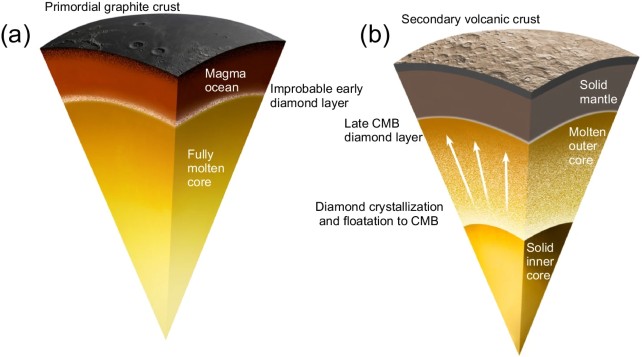
This was presuming a sulfur content of around 11 percent, and a pressure of roughly 1 to 2 percent of that found deep inside the Earth – both plausible given what we now know of Mercury's development.
With those assumptions in mind, taking the production of diamonds into account could influence models of Mercury's internal dynamics, especially considering the crystal's exceptional thermal conductivity.
The way heat rises from the core not only affects predictions on planetary cooling, and the evolution of other rocky worlds like it, but the movement of materials responsible for the generation of magnetic fields.
In spite of its comparably tiny size, Mercury is the only rocky planet other than our own to harbor a magnetosphere. What's more, though significantly weaker than Earth's, this magnetic field could be far older.
Understanding why Mercury's magnetic bubble has persisted for so long could require rethinking what lies deep beneath its skin.
This research was published in Nature Communications.
Sierra Space’s Next-Gen Space Station Will Be an Absolute Beast, Passes Crucial Trial
As Sierra Space engineers get a better picture of what systems are flight-ready and which need more fine-tuning before launch, valuable data about the operating parameters of each system will lend crucial data that ensure successful deployment and operation the first time when humans need them the most to them alive in the hostile environment of low-Earth Orbit. With its unique inflatable form factor, Sierra Space can tailor the layout and features of each bespoke space station to make the most use of the limited space available on board.
From astrophysicists observing deep-space phenomena via telescopes in Orbit, free of distortions and interference here on Earth, to botanists learning how to grow food on rugged alien worlds, no task performed regularly in the vacuum of space is off limits for Sierra Space's proprietary orbital station technology. With the de-orbit of the International Space Station looming large over the future of NASA, the ESA, and its associated partners, these station tests and those like it performed by other companies are a welcome sign that the gap left behind won't be long-lasting.
The ultimate goal is the full human-rated certification of the pressure shell that makes up Sierra Space's life habitat module. With considerable tweaks to the exterior structure of the test article compared to similar trials performed previously, there's every reason to suspect Sierra Space is closer to commercial viability than all but the most well-funded and innovative of its competitors. But in the future privatized space sector, there's bound to be plenty of room for competition. Unlike most industries, at least it's all in the name of science.
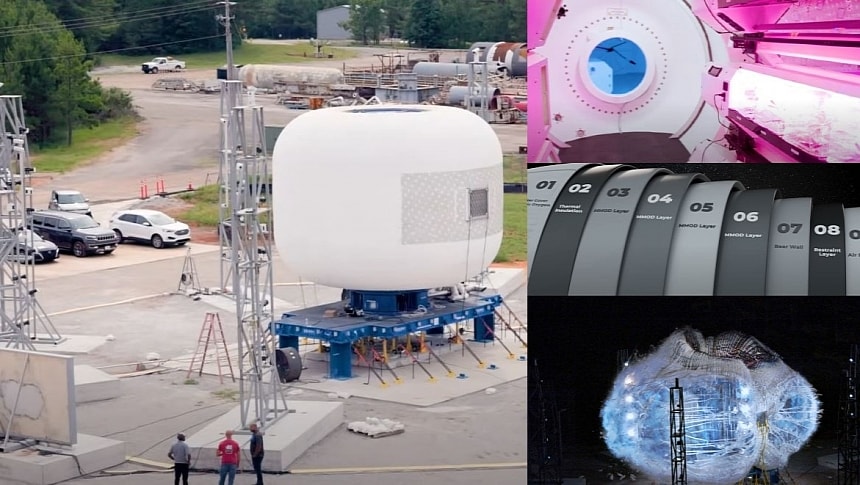












No comments:
Post a Comment